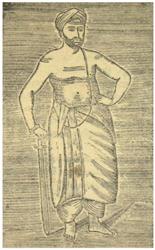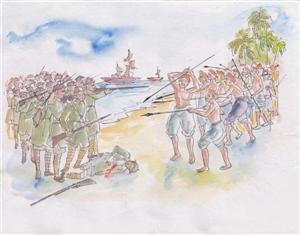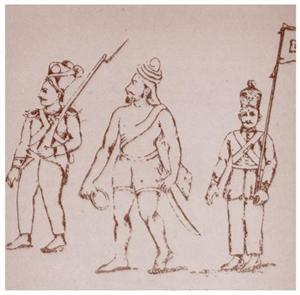Marthanda Varma in friendship with the English - Dutch forces.
The victory of king in the Battle of Kulachal and decline of the Dutch power.

When there was dispute between the Dutch and Marthanda Varma in south Kerala (Malabar), there took place many events in north Kerala. The French and the Dutch were strengthened themselves at a fast rate. In February 1739 an English ship, Harington came over India with important orders for the British. Amongst them there was an order of the English East India Company reorganising its trade centers. Stephen Lo was appointed as the president and governor of Bombay. William Wake was transferred from Anjengo to Tellichery as the head of the Factory. There arose an imbroglio at the royal family of Kolathiri when the British imprisoned a prince named Okku. The dispute between the British and the French took a turn for the worse when the former captured a hill near Mahi. But the two European powers that locked horns at north Kerala were friends of Marthanda Varma who was moving against Dutch. He used to gather arms from the two friends.
In 1740, when Marthanda Varma was readying himself for his invasion at the north, the close kin of the Nawab of Arcot, Chanda Sahib and Beda Sahib attacked the places Nagarcoil, Suchindram. To confront the enemy Marthanda Varma deployed his close loyalist Dalava Ramayyan who paid to the invaders huge amount for their withdrawal.

Dutch and the Marthanda Varma
There took place no meeting between Marthanda Varma and Van Imhoff at Desinganadu, as was promised to the Governor. Instead, the king expressed his unwillingness to give pepper to the Dutch. He was of the opinion that the price of the Dutch to the pepper was comparatively less and that their transactions were not correct and regular. While the Dutch was adamant that they be allowed to collect from Peraka Thavazhy and Desinganadu the king was equally adamant in not allowing the same. The Dutch then arrived at a conclusion that there was no other way than military action against the king. Their plan was to extend the support to the kings of Cochin, Desinganadu and Vadakkamkoor along with invading Nedumangadu and Karunagapally. As part of that plan, they enthroned the queen of Elaidathu (Kottarakkara) again. The queen then handed over to the Dutch a place called Ayiroor where the Dutch erected a small fort. But the armed forces of Travancore reached there and lay a siege around the fort. With this the queen escaped to Cochin and took shelter there. Though she was sanctioned a pension by the Dutch, she committed suicide as per the versions of some historians.
The Dutch and the Marthanda Varma continued their attack and counter attack. In the meanwhile the Dutch was expecting more troops from Batavia. Cochin and the countries to which it had trade relations had been clamouring for the blood of Marthanda Varma who did not remain idle. Besides the neighbouring countries he crossed over Cochin and attacked and subdued Kolathunadu and Kozhikodu came under the jurisdiction of the Zamorin. His aim was Greater Kerala. Marthanda Varma continued his war preparations by improving the state's finance, by inducting those who deserted the Dutch forces into his armed forces, improving the trade relations with the English East India Company of Anjengo, collecting arms from them and by forging alliance with the French.
In 1740 Marthanda Varma made a treaty of friendship with the French. With this the French were able to establish their influence in Kulachal along with purchasing pepper and other goods from Travancore. He was able, by this treaty, to avoid the impending invasion of Chanda Sahib and Bada Sahib at Trivandrum since the Carnatic Nawab was a close ally of the French. During this period, the Dutch was attacking different parts of Travancore with their eyes on the long stretch of land lying between Kulachal, a textile centre and Cape Comerin. It was from this stretch the king got the taxation revenue. The estimate of the Dutch was that if it was blocked his ability to wage a war would be declined. With this view, the Dutch laid a siege in the seas. By the end of November the Dutch fleet continued the attack in the seas and the people who inhabited at the coastal areas started to take to their heels. But the king's troops numbering about 2000 came fully armed and blocked the siege at the sea. As the monsoon was set in the Dutch stopped the attack but still the sea coast between Quilon and Cape Comerin were under their offence. It affected the trade of the English, from whom Marthanda Varma gathered fire arms and weapons and became ever ready for the war.

Marthanda Verma started readying himself for the war with the Dutch after his sword (hung from the girdle) was placed at the temple Adhi Keshava Perumal Thiruvattar and conducted pooja on it. Eventhough there was attack against the fort of Kulachal by the troops of Tranvancore, the Dutch put up a strong defence. Heavy rains became a threat to the warring sides. The Dutch did not get the help they anticipated from Cape Comerin and other places because of the inclement weather. The Dutch commander Rijtel was wounded in the battle and before the king who arrived at the battle field 31Dutch troops surrendered. Even though the Dutch tried to recapture the long fort the troops of Travancore resisted it. In the meanwhile Dutch gun powder store house was set afire by a fire bomb launched by the troops of Travancore. With this the horrified Dutch troops started running scattered and the Dutch force was in a state of abject surrender. But the surrender actually took place on 12 August 1741. It was from here that there started the decline of the Dutch power and the upsurge of the majesty of the adventurous king Marthanda Varma. He was vested with the glory of 1st Indian ruler who defeated a European power. Inclement weather conditions, the strategies of the king of Travancore and the miscalculation on the part of the Dutch as to the military might of Marthanda Varma were the reasons of Dutch fiasco. Still the Dutch continued waging the war.
